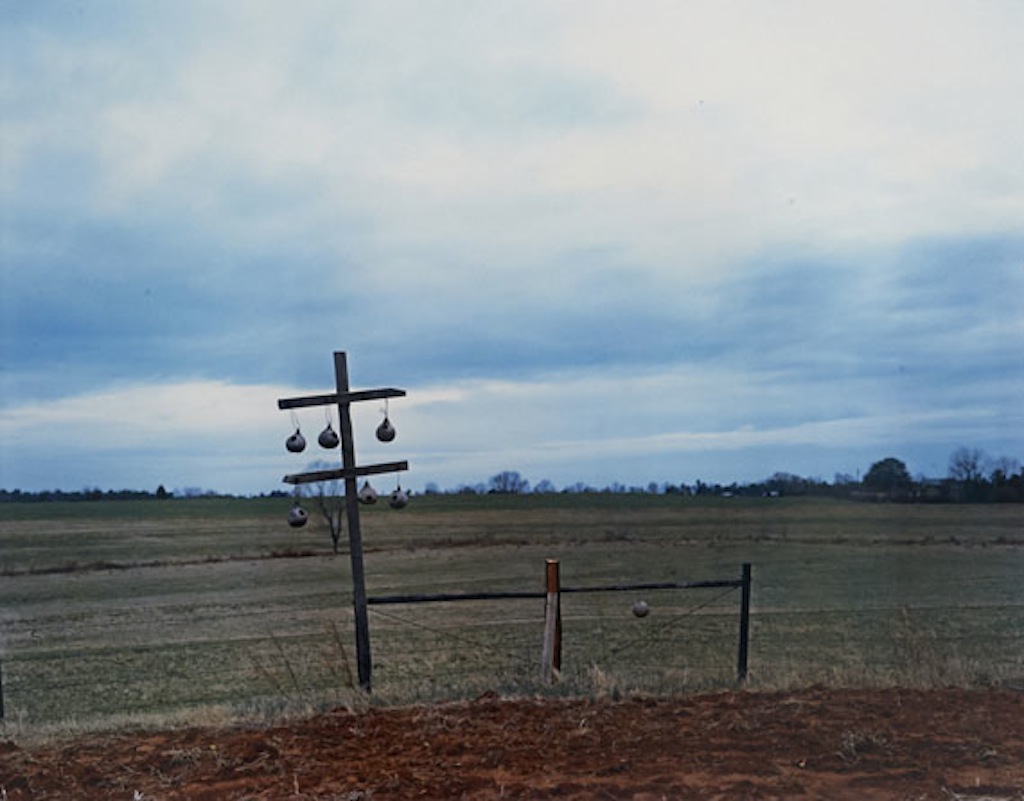
© William Christenberry Gourd Tree, near Akron, Alabama, 1981
Feroz Galerie Prinz-Albert-Str. 12 D-53113 Bonn Allemagne
In Christenberry, there is the theme of continuity and rebirth, as well as an extreme reverence for the land. Without its ever being maudlin of sentimental, there is a belief in human goodness and redemption—in virtue and hard work and effort, however tattered.Walter Hopps, former director of the Pasadena Art Museum
William Christenberry’s distinctive art emerged in the 1960s, informed by a deep attachment to the rural landscapes and the material culture of his boyhood home in Alabama. Already familiar with Walker Evans’s photographs documenting the effects of the Great Depression in the South, Christenberry met with Evans at Time-Life in New York to show him photographs that he had made with an amateur Brownie camera. Impressed with the pictures, Evans described them as “perfect little poems,” encouraging Christenberry to return to the South to continue his work. As a result of this meeting, photography became a more important part of Christenberry’s artistic production and presented alongside his paintings, drawings and sculptures
In 1968, Christenberry began teaching at the Corcoran College of Art and Design in Washington D.C., he spent his summers in Tuscaloosa, Greene and Hale Counties in Alabama making photographs and collecting found objects for his sculptures and paintings. Demonstrating a firm loyalty to place, his photographs document the quiet ‘memories of things gone missing’ and the ‘passage of time’. In the late seventies, Christenberry began using an 8 x 10 Deardorff large format camera with Kodachome transparencies, which he believes make the best dye-transfer prints. Often returning to the same locations to photograph, his painterly compositions capture the lush humid colors of the Southern landscape and the warm weathered surface textures of the local architecture inviting us to look closer.

© William Christenberry, Horses and Black Buildings—Newbern, Alabama, 1978
“William Christenberry: Southern Dialogue,” presents a selection of works created over the past half century. Including the sculptures China Grove Memory (1980) and Spare Parts Box (1978-1981), drawings and multimedia works on paper, vintage dye-transfer prints from the portfolio Ten Southern Photographs (1981) and select digital pigment prints on Hahnemuhle paper.
William Christenberry (1936) was born in Tuscaloosa, Alabama. He is Professor Emeritus of the Corcoran College of Art and Design, Washington D.C. (1968-2009). His work is in major permanent collections, including the Museum of Modern Art, the Metropolitan Museum of Art, International Center for Photography, and the Whitney Museum of Art in New York; the George Eastman House, Rochester; the Menil Collection, Houston; the Smithsonian American Art Museum and the Phillips Collection, Washington, DC; the Philadelphia Museum of Art; the San Francisco Museum of Modern Art; J. Paul Getty Museum and Los Angeles County Museum of Art; the Stedelijk Museum, Amsterdam; Die Photographische Sammlung / SK Sktiftung Kultur, Cologne. Recent solo exhibitions include “Passing Time: The Art of William Christenberry” at the Smithsonian American Art Museum, Washington D.C. (2006-2007), and “William Christenberry,” at the Palais des Beaux-Arts, Brussels and Die Photographische Sammlung / SK Stiftung Kultur, Cologne (2002).

© William Christenberry, 5¢—Demopolis, Alabama, 1978
Select Monographs include: William Christenberry: Kodachromes (2010); Working From Memory (2008); William Christenberry: Disappearing Places (2007); William Christenberry (2006); William Christenberry: The Early Years, 1954-1968 (1996); William Christenberry: Art & Family (2000); Christenberry Reconstruction: The Art of William Christenberry (1996); William Christenberry: Southern Photographs (1983).
Photography © William Christenberry

